

The Kagyu (bka’ brgyud) lineage is sometimes referred to as the “lineage of oral-instructions”. The “Ka” (bka’) of Kagyu refers to the authoritative instructions, precepts or words (Skt. vacana) of the Buddha while “gyu” (brgyud) is the uninterrupted lineage of masters and students.
The founder of the Kagyu lineage was the Mahasiddha Tilopa (988-1069), who lived in Northern India. He is considered having received a direct transmission from the primordial Buddha Vajradhara. In this context the Kagyu lineage has originated from the very essence of reality itself and thus transcends all space and time.
Viewed from another level of understanding he also had human teachers, from whom he received four special transmissions, The Four Oral Instructions (bka’ babs bzhi) for which he became the lineage holder.
Some etymologies of the name “Kagyu” consider it as a abbreviation of Lineage of Four Oral Instructions (bka’ babs bzhi brgyud pa).
When Tilopa’s transmission is linked directly to Vajradhara, it is called the “direct transmission” but when it is traced to his human teachers, it is referred to as the “indirect transmission.”
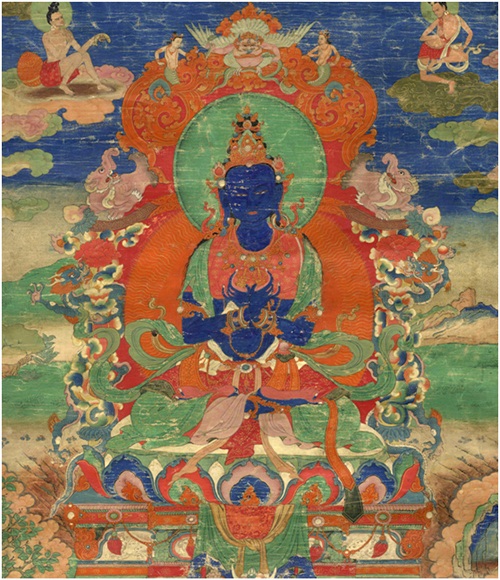
Although there is some discrepancy in historical sources regarding the identities of the yoga masters associated with each of the four transmissions, the most common consensus indicates that their origins are as follows:
- The first of the four came from Lopon Ludrub (slob dpon klu sgrub, Skt. Acarya Nagarjuna) and consists of two tantras, the “Sangwa Dupa” Tantra (gsang ba dus pa, Skt. Guhasamaja) and the tantra called “Denshi” (gden bzhi). This transmission also incorporates the practices called “Illusory Body” (sgyu lus, Skt. Mayadeva) and “Transference” (pho ba, Skt. Samkranti).
- The second special transmission came from Nakpo Chopa (nag po spyod pa). It includes the tantra called “Gyuma Chenpo” (sgyu ma chen po, Skt. Mahamaya) and the practice called “Conscious Dreaming” (rmi lam, Skt: Svapna).
- The third special transmission came from Lawapa (la ba pa) and is called “Demchok” or, alternatively, “Khorlo Dompa” (bde mchog, khor lo sdompa, Skt. Chakrasamvara), and the practice called “Clear Light” (odgsal, Skt. Prabhasvara).
- The fourth was transmitted from Khandro Kalpa Sangmo (mkha gro bskal pa bzangmo) and includes the tantra known as “Gyepa Dorje” (dgyes pa rdo rje, Skt. Hevajra) and the practice called “Tumo” (gtum mo, Skt. Candali). These transmissions form the core of the precepts and secret instructions of the Kagyu lineage that is transmitted from generation to generation, uninterrupted from master to disciples. The contents of the Four Oral Instructions include both the path of means and the path of liberation.
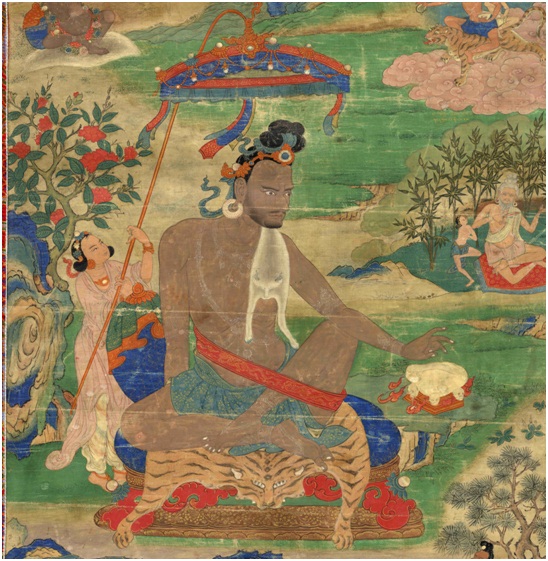
These teachings were passed from Tilopa to his disciple, the Mahasiddha Naropa (1016–1100) and they were systematized as the Six Yogas of Naropa, meditations that are considered an essential teaching of the Kagyu lineage.
Naropa transmitted his knowledge to Marpa Chökyi Lodrö (1012–1097), the great translator, who journeyed from Tibet to India in order to receive instructions and who subsequently returned to Tibet and spread the teachings of the Dharma widely.
Marpa’s most important disciple was Jetsun Milarepa (1040-1123). He became one of Tibet’s great yogis. His life story, beginning with difficult circumstances due to his father’s early death, his vengeance upon his dishonest aunt and uncle, and his subsequent regret which led to an earnest desire to enter the way of the Dharma, is widely known among Tibetans.
Through his perseverance and ability to accept all circumstances which he met, he achieved profound realization of the ultimate nature of reality. His teachings are recorded in the 100,000 songs of Milarepa and other collections.
Milarepa’s teachings were carried on by Gampopa (1079-1153), also known as Dakpo Lhaje, the physician from Dakpo. He first studied under the Kadampa tradition, which is a gradual and systematic path. At a later age, he met Milarepa and practicing under him received and realized the true meaning of the complete teachings.
Since that time, the lineage has been known as the Dakpo Kagyu. It is from Gampopa that the first Kagyu schools originated: the Karma Kagyu, Tselpa Kagyu, Barom Kagyu, and Phagdru Kagyu.
The founder of the Phagdru Kagyu was Phagmodrupa Dorje Gyalpo (1110–1170), one of Gampopa’s most important disciples. His own lineage died out as a religious institution, while his clan played an important role in the country’s secular governance in the ensuing epoch. Phagmodrupa’s main disciples founded their own lineages, of which only three are still extant: the Drikung Kagyu, Taklung Kagyu, and Drukpa Kagyu.
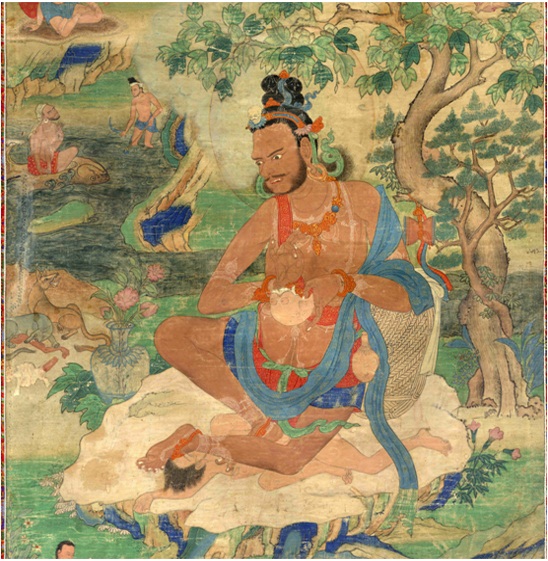
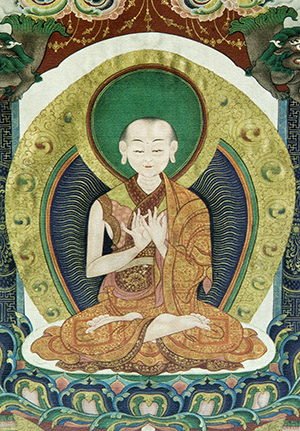
Phagmodrupa’s Heart Son, Kyobpa Jigten Sumgön (1143-1217) took over the throne of Phagdru at Densa Thil Monastery for three years after his teacher’s death (1177-1179). He then established his own lineage with the foundation of Drikung Thil Monastery in the area of Drikung, as Phagmodrupa had predicted.
Although Phagmodrupa had countless students, Jigten Sumgön was one of his closest and principal disciples. Phagmodrupa prophesied that a Bodhisattva (Jigten Sumgön), who already attained the ten Bhumis (the stages on the path of a Bodhisattva), would carry on the teachings and blessings. Jigten Sumgön received the complete teachings, secret oral transmissions, explanations and initiations, and enlightened realization blessings, and so forth from Phagmodrupa. In turn Jigten Sumgön transmitted the complete teachings to his chief disciple, Gurawa Tsultrim Dorje (1154-1221). [Read more on the life of Jigten Sumgön].
Kyobpa Jigten Sumgön was a descendant from the Kyura clan. As was the custom in many schools of Tibetan Buddhism, Jigten Sumgön chose his successor from among his relatives. Thus, initially all but three Drikung Kagyu throne holders came from the male offspring of the Kyura clan, although there were no set guidelines for the succession among the family members. From the very beginning in Drikung powers were shared; spiritual leadership was reserved to the Denrab (gdan rabs), the throne holder, while secular matters were under the governance of a Gompa (sgom pa), a civil administrator. Both usually were members of the Kyura clan.
In the early years of the order a sub-sect known as the Lhapa Kagyu emerged from one disciple of Jigten Sumgön, named Gyalwa Lhanangpa (1164-1224), but this lineage did not continue for long.
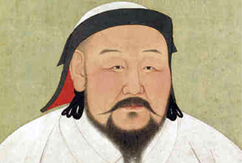
Several of the early Drikung Denrab attained prominence, among them Chenga Drakpa Jungne (1175–1255), a heart son of Jigten Sumgön, who was entrusted with the leadership of Phagmodrupa’s monastery, Densa Thil. He led the monastery to a new period of flowering and took over the throne of the Drikung in 1235. He guided the order through difficult times with a calm and steady hand. When the Tibetans revolted against Mongolian overlordship and stopped paying tribute, Ogodei (1186–1241), the son and successor of Genghis Khan (1162–1227), ordered a horrific punitive action in 1239.
Mongolian troops burned down many monasteries, among them Reting (rwa sgreng), where they slaughtered 500 monks and moved on towards nearby Drikung. The secular ruler of Drikung opposed them, was taken prisoner and was to be killed. It it said that stones rained down from the skies when Drakpa Jungne hastened to the Mongolian forces from Drikung Thil. Perhaps it was just a strong hail-storm. In any event, his courageous intervention resulted in a peace settlement with the Mongolians. The brutal attack on Reting Monastery was evidently meant as a warning to Drikung. But Drikung was spared a confrontation with an uncertain outcome, and rose to become a major power in central Tibet.
Kunga Gyaltsen, later known as Sakya Pandita (1182–1251), concluded a pact with Godan Khan, Ogodei’s general, in which Tibet accepted Mongolian suzerainty and agreed to pay tribute. The settlement that Kunga Gyaltsen had reached with Tibet’s powerful neighbor did not meet with unanimous support in his homeland. Many Tibetan noblemen resisted the demands for tribute. Mongolian troops put down their rebellion with a bloody and crushing defeat in 1251.
Kunga Gyaltsen’s nephew and successor, Phagpa Lodrö (1235–1280), became the spiritual teacher of Khubilai Sechen, Great Khan of the Mongols since 1259, and later of Great Khan Khubilai (1215–1294). Their close contacts with the Mongols enabled the Sakya sect to assume political leadership within Tibet, as the ambitions of the Karma Kagyu to win support of the Mongols were unsuccessful. In 1275, Khubilai Khan gave Phagpa Lodrö the provinces of U and Tsang, as well as Kham and Amdo as feudal fiefdoms. The provinces were divided up into so-called myriarchies, administrative areas theoretically encompassing 10,000 families. When Khubilai became Emperor of China in 1279 and founded the Yuan Dynasty, he conferred on Phagpa Lodrö the title of “Imperial Preceptor.” In this way, for the first time in Tibet, the hierocratic form of government was constituted in a relationship of patronage between the Emperor and his spiritual teacher.
Resistance to this transformation of the country into feudal fiefdoms began to stir among the Tibetan aristocracy, especially in the provinces of Ü (dbus) and Tsang (gtsang) in central Tibet, closely connected with the Drikung, Phagdru and Karma Kagyu. At the same time, the Mongolian tribes were engaged in struggles over leadership and landed estates among themselves. Drikung had risen to great power by this time. Reports exist that even as early as the rule of the 5th Denrab, Chung Dorje Drakpa (1210–1278), great numbers of monks were streaming to the Drikung monasteries. After the death of the Great Khan Mongke in 1259, Hulagu (ca. 1217–1265), Khubilai’s brother and rival, became the protector of the Drikung Kagyu order and he sent a small Mongolian unit to Drikung for their safety and security.
But soon rival Mongol groups were battling out a dispute among themselves on Tibetan soil that would later go down in history as the war between Drikung and Sakya. This was not a “war of religion,” or a feud between two schools of Tibetan Buddhism, as is often claimed, but rather an attempt on the part of a few provinces of central Tibet to revolt against the overlordship forced on them by Khubilai with support from rival Mongolian groupings. The actual local conflict centered on disputes concerning the succession in Phagmodrupa’s monastery of Densa Thil. Here, branches of familial lines of the Lang clan were pursuing interests that were at variance with each other. One branch was supported by the Sakyapa and the other by the Drikungpa. The war broke out under the 7th throne holder, Tsamche Drakpa Sonam (1238–1286). In 1290, under his successor Nub Chogo Dorje Yeshe (1223–1293), Drikung Thil Monastery was devastated by Mongolian troops. This disaster did not come unexpectedly for the local population. As Dorje Yeshe was not a member of the Kyura clan, but of the Nub clan, he lacked support in difficult times, because of the prevalent view that it was not in accordance with the wishes of the lineage founder for a clan-outsider to occupy the throne of Drikung.
Drikung Thil was rebuilt under the 9th throne holder, Chunyi Dorje Rinchen (1278–1314), with support from the Emperor and the Sakyapa. But the powerful influence that the monastery had exercised for decades in Tibet was gone. Dorje Rinchen laid down a new rule of three yearly periods for monastic instruction.
While primarily philosophical texts of the lineage and the fundamentals of Mahayana Buddhism were taught in spring and autumn, in summer teachings on the Fivefold Path of Mahamudra were given. In winter, wearing only light cotton garments, Dorje Rinchen taught the Six Yogas of Naropa on the great terrace outside the main temple of Drikung Thil.
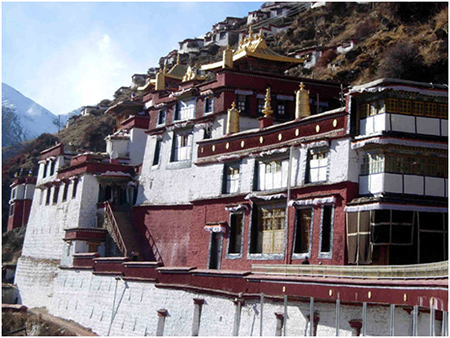
In the 14th century, the Phagmodrupa assumed secular leadership in central Tibet. Members of the school of Tibetan Buddhism of the same name that was in a state of decline are not being referred to here, but rather the rulers of the Lang clan that was closely associated with the Phagdru order. The central figure of this epoch was Jangchub Gyaltsen (1302–1373), both a skillful politician as well as a monk of the Phagdru Kagyu. He led the country to greater independence and created a new system of administration. His reforms worsened relations with Drikung, leading to armed conflicts with the Phagmodrupa. After initial successes, the Drikungpa were forced to accept a few painful defeats on the battlefield and come to terms with the rule of the Phagmodrupa in northern Ü. Towards the end of Jangchub Gyaltsen’s life, the Drikungpa succeeded in reestablishing the autonomy of their lands. At about this time, a shift in the balance of power was taking place in Asia through the fall of the Yuan Dynasty and the ascent of the Ming Dynasty (1368–1644) as China’s imperial house. But the Mongols still remained a force that both Tibet and the Ming Emperors had to reckon with.
In the midst of all this turmoil, Chenga Chökyi Gyalpo (1335–1407), the 11th throne holder, attempted to raise the spiritual level of the Drikung order once again. He had the Kangyur of Narthang and the newly edited version of the Tengyur copied. Tsongkhapa (tsong kha pa, 1357-1419), the founder of the Gelug sect, traveled from Amdo to Drikung in 1373, and became a disciple of Chökyi Gyalpo. His family settled in a village about 40 kilometers away from the monastery. Tsongkhapa received the Drikung teachings on the Six Yogas of Naropa as well as all of the outer and inner texts by Jigten Sumgön.
In the 15th century, the Ming Dynasty recognized the Drikungpa’s renewed and increasing influence and granted the throne holder the honorific title of Ch’an chiao wang that was conferred on the heads of the eight most important schools or monasteries. For two centuries Shigatse in the province of Tsang became the center of power in Tibet, first under the rulers of Rinpung (1436–1566), later under the Tsangpa (1566–1642). Since both noble families supported the Karmapa, the Karma Kagyu advanced to become the most influential school of the epoch.
Two outstanding personalities on the throne of Drikung left their marks in the beginning years of the 16th century: Gyalwang Kunga Rinchen (1475–1527) and his successor Gyalwang Rinchen Phuntsog (1509–1557). Kunga Rinchen was regarded as the reincarnation of Jigten Sumgön. He aspired to improve the quality of spiritual life. Kunga Rinchen dedicated himself intensively to giving transmissions and teachings, and he was also committed to reviving the tradition of retreats. Many of his new disciples, who were streaming to Drikung, were sent by him to do retreats at Mt. Kailash, Tsari and Lapchi. Under his direction, 50 new meditation huts were built at Drikung Thil Monastery. The Kangyur and Tengyur were copied on indigo paper in gold and silver script, while two hundred scribes were involved in the production of the complete texts of the Drikung lineage.
Rinchen Phuntsog, the 17th Drikung Denrab, was a great reformer. After receiving transmissions from various lineages, he integrated doctrines, rituals, and meditational practices above all of the Nyingma order into the traditional Drikung Kagyu teachings, thereby opening up and augmenting its dogmatic orientation. Rinchen Phuntsog discovered the treasure text Gongpa Yangzab in the Kiri Yangdzong Cave in the valley of Terdrom. Rinchen Phuntsog was an assiduous author whose writings are also highly regarded by the Nyingma, and were included in the collection of Nyingma tantras.
Rinchen Phuntsog’s only son, Chogyal Rinchen Phuntsog (1547–1602), was the 21st Denrab on the Drikung throne when Altan Khan (1507–1582), the powerful ruler of the Tumat Mongols, entered into an alliance with Sonam Gyatso (1543–1588) from the Gelugpa sect that was to influence the future course of Tibetan history decisively. The Mongolian ruler conferred the title of Dalai Lama on Sonam Gyatso and accorded him extensive privileges. Sonam Gyatso became the 3rd Dalai Lama because his two predecessors were given the title of Dalai Lama posthumously. As a result of many armed conflicts during the latter part of the 16th century, Chogyal Rinchen Phuntsog had the Drikung Dzong complex expanded into a fortress.
The first phase of succession to the highest office within the lineage ended with the sons of Chogyal Rinchen Phuntsog. His eldest son, Naro Tashi Phuntsog (1574–1628), called Naro Nyipa (“The second Naropa”), succeeded to the throne, while his younger son, Garwang Chökyi Wangchug (1584–1630), was recognized as the 6th Shamarpa. His two youngest sons, Gyalwang Konchog Rinchen (1590–1654) and Kunkhyen Rigzin Chödrak (1595–1659) became the last heirs to the throne of Drikung; the Kyura lineage died out with them. Upon the death of Konchog Rinchen the Drikungpa began to seek the reincarnations of their throne holders. A system of two lineage holders was established, that of the elder (Chetsang) and the younger (Chungtsang) brother. In the Drikung chronology Konchog Rinchen is considered as the first Chetsang and Rigzin Chödrak as the first Chungtsang. Both bear the title Drikung Kyabgon (‘bri gung skyabs mgon).
During the time of the 1st Chetsang Rinpoche, Konchog Rinchen (1590–1655), the Tumat Mongols were claiming rights to Tibetan lands and properties, as the 4th Dalai Lama was a descendant of the Tumat clan. Thus the Drikungpa again found themselves embroiled in armed conflict and the fortress of Drikung Dzong fell to the onslaught of Mongolian troops. The entire region of Drikung lay in such ruin that Konchog Rinchen was unable to live there for a long time. When the Tsangpa king, Phuntsog Namgyal, succeeded in driving back the Mongols, Konchog Rinchen rebuilt Drikung Dzong in a very short time in 1624. He named the new building Namgyal Chodzong. But the warfare continued with the forces of Gushri Khan, the ruler of the Khoshuud, securing power in Central Tibet to the 5th Dalai Lama (1617–1682) with decisive victories against his opponents. The Gelugpa advanced to dominance over the entire country. The Dalai Lama enforced the supremacy of the Gelugpa over the other schools of Tibetan Buddhism, proceeding with especial severity against the Karma Kagyu. In Drikung, nothing remained of countless villages but their names. Monasteries and noble residences fell prey to the depredations of the Mongolian army, as did the recently erected Namgyal Chödzong.
In the midst of this epoch of devastation and ruin, Drikung became famous far and wide as an admired and feared center of magic. This reputation was traceable to the activity of Konchog Rinchen’s brother, the 1st Chungtsang Rinpoche, Rigzin Chödrak. Rigzin Chödrak founded an important school of astrology and divination in Drikung and he was also the founder of the Drikung system of medicine, one of Tibet’s four medical traditions.
Under the 2nd Chetsang, Konchog Thrinle Sangpo (1656–1718), the custom of first enthroning the Kyabgon Rinpoches in Drikung Tse Monastery was introduced. Thrinle Sangpo founded one of the four great schools of painting in Tibet, the so-called Driri style of Drikung. In the Snake Year 1677 he introduced the Snake Year Teachings on the threshing ground of Drikung Tse, where he gave initiations and teachings on the Chakrasamvara and Guhyasamaja tantras. In 1681 he had Yangrigar Monastery completely rebuilt, as it had been largely destroyed by the ceaseless warfare. Today he is regarded as the monastery’s founder. He also started to restore Drikung Dzong amidst the turmoil of another Mongolian invasion in 1717, during which the Dzungars overran Lhasa and burned and plundered numerous Nyingma monasteries.
Thrinle Sangpo guided the lineage alone for a long time, because the reincarnation of Chungtsang recognized by the 10th Karmapa had died in a smallpox epidemic before he could be brought to Drikung. Thus, it took until 1704 for Chungtsang to reincarnate in Thrinle Döndrup Chögyal (1704–1754). Döndrup Chogyal, who became known under the name Drikung Bhande Dharmarāja, founded several new monasteries. In his work Jewel Treasury of Advice he had summarized the entire structure of the Buddhist path according to both Sutrayana and Tantrayana.
The 3rd Chetsang Konchog Tenzin Drodul’s (1724–1766) life was overshadowed by disputes in his monasteries. He intentionally withdrew from active life and spent almost his entire time in meditation in his room in the palace of Trolung. Tenzin Chökyi Nyima, the 3rd Chungtsang (1755–1792), son of a noble family from Jangyul, also failed to make much headway against this state of affairs, although he made every effort to renovate the monasteries and purify discipline. The 4th Chetsang, Tenzin Peme Gyaltsen (1770–1826), gained fame as the author of a biographical history of the Drikung Kagyu throne holders, Masters of the Golden Rosary Lineage. When the 4th Chungtsang Tenzin Chökyi Gyaltsen (1793–1826) died in the same year as Peme Gyaltsen, it became necessary for a regent, Lhochen Chökyi Lodrö (1801–1859), to guide the lineage.
Konchog Chönyi Norbu (1827–1865), the 5th Chungtsang, and Konchog Thukje Nyima (1828–1885), the 5th Chetsang, were enthroned at the same time on Jigten Sumgön’s red earth throne near Drikung Thil. During their leadership the Sikhs conquered Ladakh and occupied the three provinces of Ngari. The Drikung monasteries in Ladakh and near Mt. Kailash suffered severe damage during these conflicts. Nonetheless the Drikung lineage was in full blossom during this period. Thukje Nyima was considered an exceptionally learned man, and particularly expert in medical matters, but was caught up in intrigues of monastic officials. Eventually Chetsang Thukje Nyima was forced by an intervention of the Tibetan government to abdicate the throne in 1854. As punishment, the golden roof of the temple in Drikung Thil was removed to Lhasa and some estates of the Drikung Kagyupa were confiscated, resulting in acute food shortages. Thukje Nyima set off in secret on pilgrimages to Mt. Kailash from his exile in Tsang, and gave teachings and empowerments in other locations. Five years later he received permission from the Tibetan government to return to Drikung.
When Chungtsang Chönyi Norbu died in 1865, monastic officials began hatching intrigues against Thukje Nyima again. Thukje Nyima was forced to leave his position in Drikung Thil once again and withdrew to Trolung for the rest of his life. Many of his adherents fell into deep despair, while he accepted all obstacles with a wide-open heart filled with bodhicitta and deep serenity. Twice in his lifetime, Thukje Nyima was the victim of defamation and monastic power-games. No doubt this was one of the saddest chapters in the history of the Drikung Kagyu lineage.
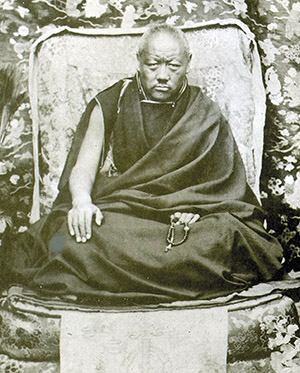
The 6th Chungtsang, Tenzin Chökyi Lodrö (1868–1906), was uncommonly tall and impressive in appearance. He wrote two comprehensive guidebooks to holy places about his pilgrimages to Mt. Kailash and Lapchi. His two scholarly works offer insight into the concept of religious geography in Tibetan Buddhism. During his stay in the Kailash region, he founded the monastic community of Phuntsogling in eastern Ladakh and recognized the 9th reincarnation of Togden Rinpoche as the religious head of the Drikung monasteries in Mangyul (Ladakh). Together with the young 6th Chetsang, Tenzin Shiwe Lodrö (1886–1943), he visited Lhasa in 1893, where the two Kyabgon Rinpoches were bestowed with the Manchurian title of hotogthu. Since that time, the Drikung Kyabgon Rinpoches have always worn the golden hotogthu hat on official journeys, in accordance with an ancient prophecy of the 1st Chungtsang Rigzin Chödrak that in the future he would wear a golden hat.
Shiwe Lodrö’s main interest lay in integrating meditative practice and philosophical teaching, as these were the central pillars of education and training in the Drikung Kagyu tradition. He also gained great fame on account of his clairvoyant abilities.
He arranged for the renovation of Yangrigar Monastery and the addition of a building for storing the wooden blocks used for printing Buddhist texts, and also introduced the first committee in Drikung Thil to improve the monastery administration. However, the poor educational level in his monasteries remained his greatest concern. In 1932, he established the Nyima Changra academy of higher Buddhist studies.
After the untimely death of the 7th Chungtsang, Tenzin Chökyi Jungne (1909–1940), Shiwe Lodrö became heavy-hearted and soon thereafter, on a journey to Kham, he suffered a stroke from which he did not recover. He spent most of his time in meditation until his death. Shiwe Lodrö perished in 1943. Since then Tritsab Gyabra (1924–1979) became the regent. Under his leadership, the present reincarnations of the 8th Chungtsang and the 7th Chetsang Rinpoches were found and enthroned as the 36th and the 37th lineage holder.

